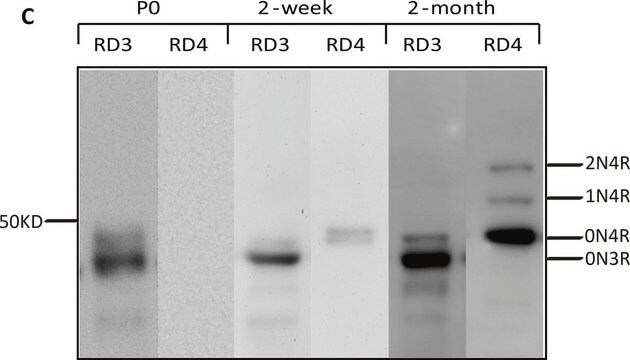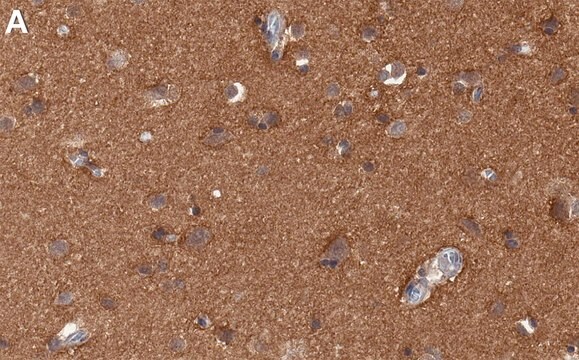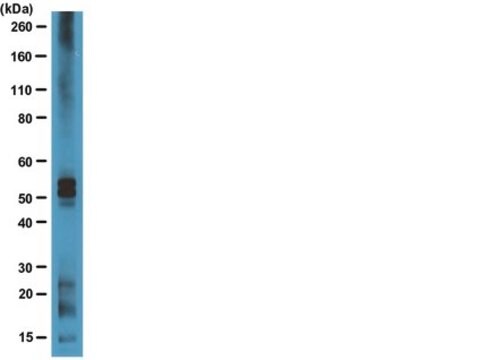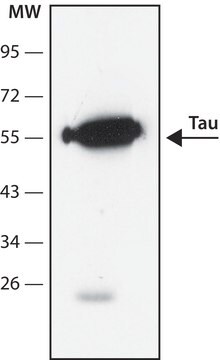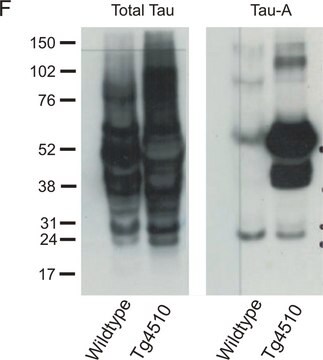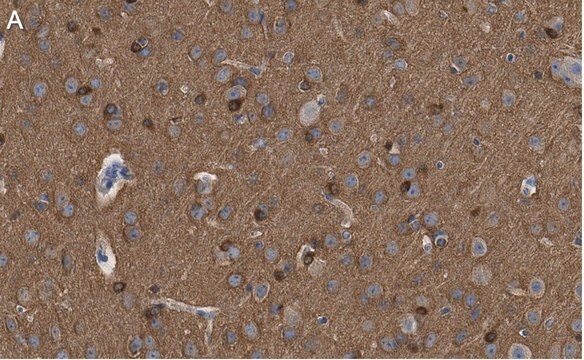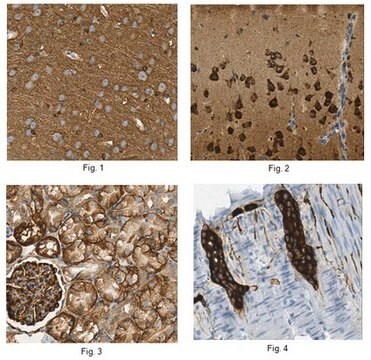MAB2241
Anti-Tau Antibody, clone Tau 12
clone Tau 12, from mouse
Synonim(y):
G protein beta1/gamma2 subunit-interacting factor 1, Neurofibrillary tangle protein, Paired helical filament-tau, microtubule-associated protein tau, microtubule-associated protein tau, isoform 4
Zaloguj sięWyświetlanie cen organizacyjnych i kontraktowych
About This Item
Kod UNSPSC:
12352203
eCl@ss:
32160702
NACRES:
NA.41
Polecane produkty
Opis ogólny
Microtubule Associated Proteins, or MAPS, bind to the tubulin subunits of microtubule structures and regulate their functional stability. In the cell MAPs bind to monomer and multimerized tubulin. MAP binding to multimerized tubulin further stabilizes the formation of higher order microtubulin structures. MAP binding to microtubule structures is mediated through phosphorylation through Microtubule Affinity Regulated Kinase (MARK). Phosphorylation releases MAPs bound to microtubules, destabilizing the structure, driving it toward disassembly. There are predominately two MAP types, I, II. Type II MAP includes MAP2, MAP4, and tau and are found in nervous tissue. Six tau isoforms exist in brain tissue, and they are distinguished by their number of binding domains. Three isoforms have three binding domains and the other three have four binding domains. The binding domains are located in the carboxy-terminus of the protein and are positively-charged (allowing it to bind to the negatively-charged microtubule). The isoforms with four binding domains are better at stabilizing microtubules than those with three binding domains.
Specyficzność
Cat. # MAB2241 recognizes the N-terminus region of Tau.
Reactivity with other species has not been determined.
Immunogen
Epitope: N-terminus
KLH conjugated synthetic linear peptide.
Zastosowanie
Anti-Tau Antibody, clone Tau 12 is an antibody against Tau for use in WB.
Research Category
Neuroscience
Neuroscience
Research Sub Category
Neurodegenerative Diseases
Neurodegenerative Diseases
Jakość
Western Blot:
Opis wartości docelowych
50-68 kDa
Powiązanie
Replaces: MAB10417
Postać fizyczna
Format: Purified
Protein G Purified
Purified in 0.1M Tris-Glycine (pH7.4) 150mM NaCl with 0.05% NaN3.
Przechowywanie i stabilność
Stable for 1 year at 2-8ºC from date of receipt.
Komentarz do analizy
Control
Human brain tissue lysate.
Human brain tissue lysate.
Inne uwagi
Concentration: Please refer to the Certificate of Analysis for the lot-specific concentration.
Oświadczenie o zrzeczeniu się odpowiedzialności
Unless otherwise stated in our catalog or other company documentation accompanying the product(s), our products are intended for research use only and are not to be used for any other purpose, which includes but is not limited to, unauthorized commercial uses, in vitro diagnostic uses, ex vivo or in vivo therapeutic uses or any type of consumption or application to humans or animals.
Ta strona może zawierać tekst przetłumaczony maszynowo.
polecane
Kod klasy składowania
12 - Non Combustible Liquids
Klasa zagrożenia wodnego (WGK)
WGK 1
Temperatura zapłonu (°F)
Not applicable
Temperatura zapłonu (°C)
Not applicable
Certyfikaty analizy (CoA)
Poszukaj Certyfikaty analizy (CoA), wpisując numer partii/serii produktów. Numery serii i partii można znaleźć na etykiecie produktu po słowach „seria” lub „partia”.
Masz już ten produkt?
Dokumenty związane z niedawno zakupionymi produktami zostały zamieszczone w Bibliotece dokumentów.
Hiroki Takeuchi et al.
NPJ vaccines, 5, 28-28 (2020-03-29)
Pathological aggregates of tau proteins accumulate in the brains of neurodegenerative tauopathies including Alzheimer's disease and frontotemporal lobar degeneration (FTLD-tau). Although immunotherapies of these disorders against tau are emerging, it is unknown whether nasal delivery, which offers many benefits over
April L Darling et al.
Protein science : a publication of the Protein Society, 30(7), 1350-1359 (2021-03-10)
Alzheimer's disease is a progressive fatal neurodegenerative disease with no cure or effective treatments. The hallmarks of disease include extracellular plaques and intracellular tangles of aggregated protein. The intracellular tangles consist of the microtubule associated protein tau. Preventing the pathological
Jessica L Binder et al.
PloS one, 15(3), e0230026-e0230026 (2020-03-26)
Pathological accumulation of microtubule associated protein tau in neurons is a major neuropathological hallmark of Alzheimer's disease (AD) and related tauopathies. Several attempts have been made to promote clearance of pathological tau (p-Tau) from neurons. Transcription factor EB (TFEB) has
Deepa Ajit et al.
The Journal of biological chemistry, 294(45), 16698-16711 (2019-09-24)
Abnormal intracellular accumulation of aggregated tau is a hallmark feature of Alzheimer's disease and other tauopathies. Pathological tau can undergo a range of post-translational modifications (PTMs) that are implicated as triggers of disease pathology. Recent studies now indicate that tau
Carmen Romero-Molina et al.
Frontiers in cellular neuroscience, 12, 421-421 (2018-11-30)
Microglial cells are crucial players in the pathological process of neurodegenerative diseases, such as Alzheimer's disease (AD). Microglial response in AD has been principally studied in relation to amyloid-beta pathology but, comparatively, little is known about inflammatory processes associated to
Nasz zespół naukowców ma doświadczenie we wszystkich obszarach badań, w tym w naukach przyrodniczych, materiałoznawstwie, syntezie chemicznej, chromatografii, analityce i wielu innych dziedzinach.
Skontaktuj się z zespołem ds. pomocy technicznej